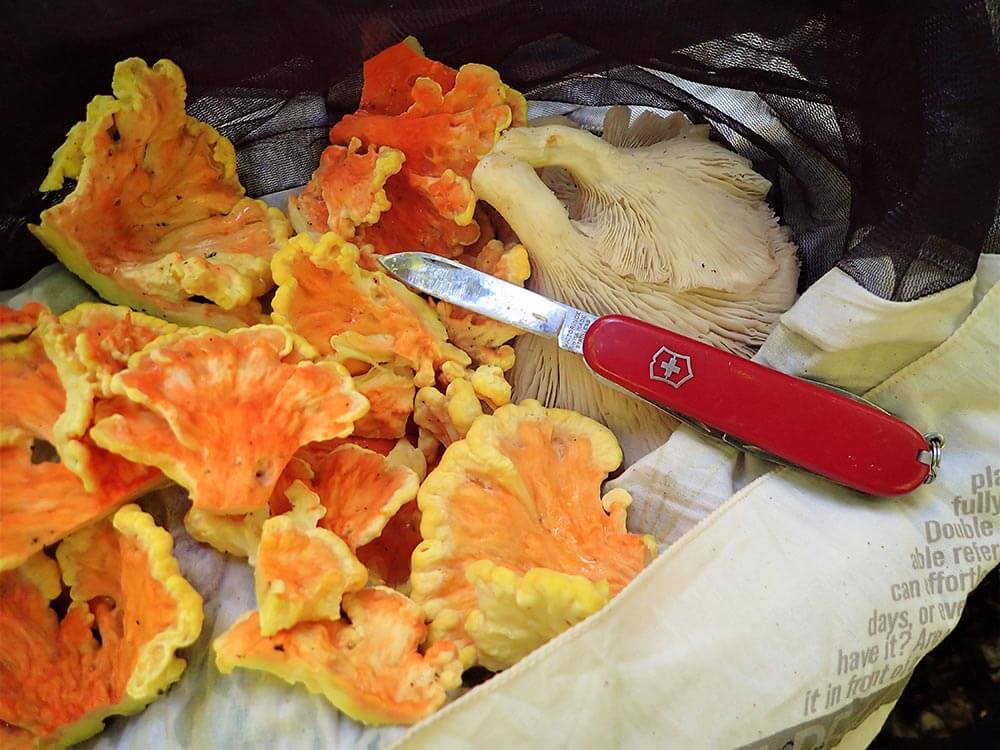FORAGE THESE EDIBLE MUSHROOMS WITH CONFIDENCE USING THESE TIPS
A good day in the world of foraging for the author as he gathers oyster mushrooms and chicken of the woods. Using a Victorinox Swiss Army Knife Camper model and Wazoo Survival Gear Foraging Bandanet made it all possible.
“What if you pick the wrong one?”
One of the most intimidating activities outdoors lovers can do is confidently pick wild food and eat it. People say, “I couldn’t ever do that” or “I’ll pick the wrong one.” These are always initial concerns. However, don’t let this fear prevent you from this experience.
Hopefully, these fungi and quick how-to-identify tips will put the fun in and remove some fear. Spore printing, using apps, and books, searching online, and asking others who are in-the-know, are all ways to positively identify plants and fungi. To make a spore print, slice off the stem of a mushroom and lay the cap – gills down – on a paper bag, dark surface, jar lid, or Tupperware lid, and wait for spore coloring.
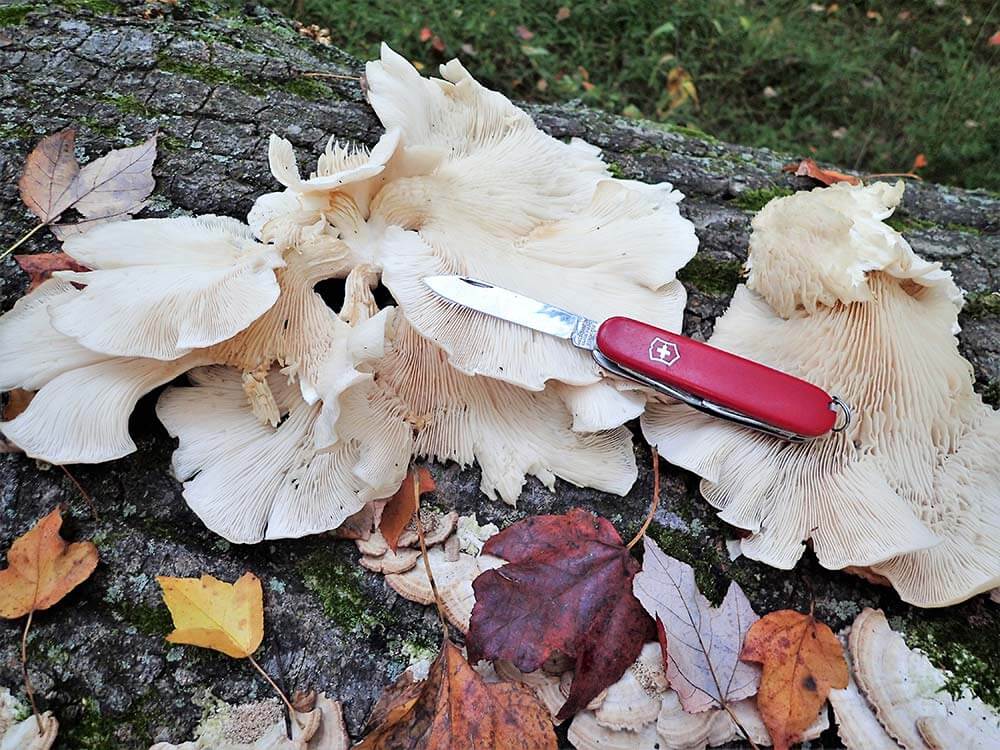
OYSTER MUSHROOMS (PLEUROTUS OSTREATUS)
This was the first wild mushroom I ever foraged. I remember coming across a downed log and seeing perfect white clusters attached to the entire side of the log. I ended up with close to four pounds of delicious pearl oyster mushrooms.
How to Identify- Oyster mushrooms form clusters called shelves on rotting or fallen logs. So, finding them means finding a few clumps, at least. Oyster mushrooms feed on dead wood, which means they are saprotrophic. They have a fishy smell, although some think it is more of a black licorice smell.
“If nothing more, photograph, pick, make spore prints, and identify. Practice good mushroom etiquette, leave some for others…”
Cap- It should be oyster or fan-shaped. Most oyster mushrooms are 2 to 10 inches wide and smooth, free of scales. The flesh is firm, white, and usually light white to brown on top.
Gills- Decurrent gills that are close, meaning they’re attached to the stem and run most of the way down it. Most Oyster mushrooms have white gills, but might appear whitish or with a gray tinge and sometimes yellowish when aged.
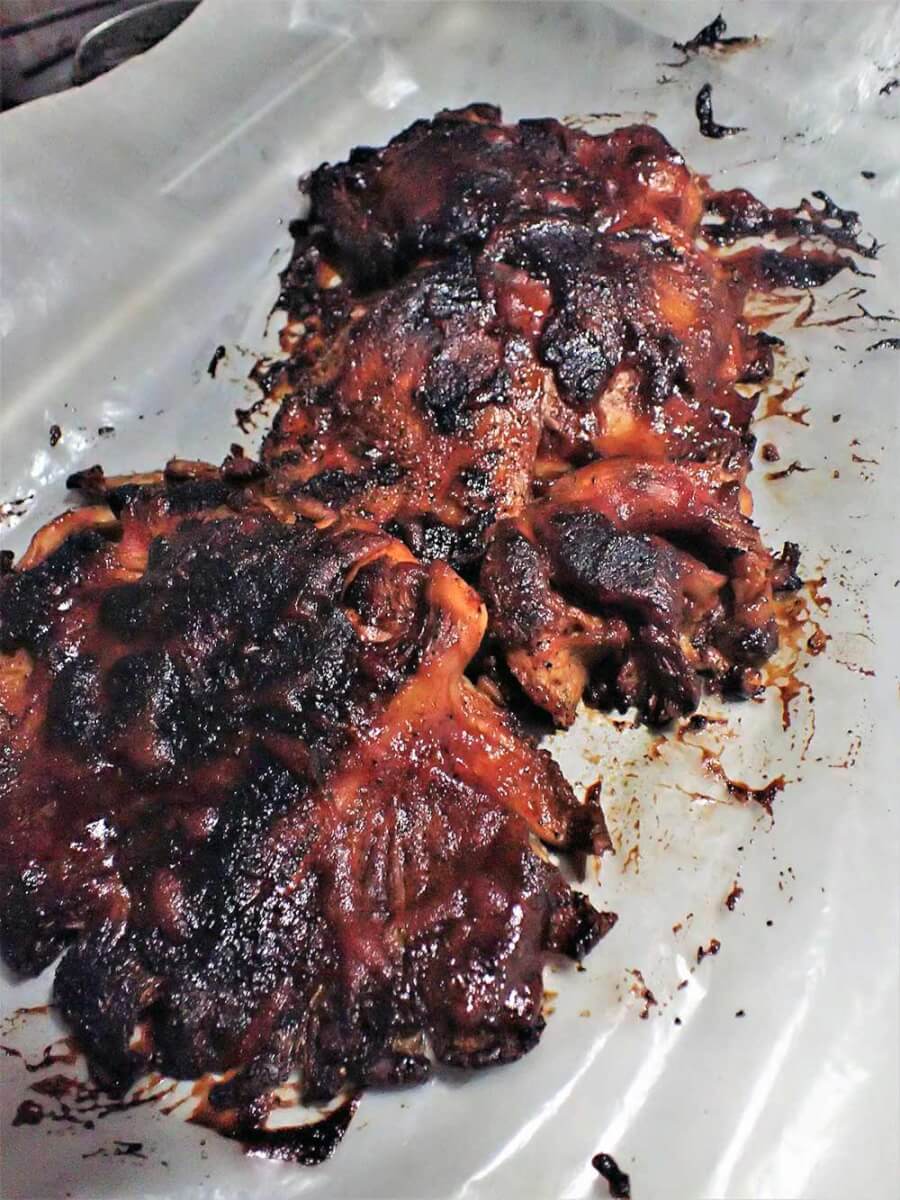
Stem- Many oyster mushrooms don’t have a stem at all. If they do have a stem (rare), it will be short, stubby, and usually growing off-center.
Spores- These will produce a white spore print.
Cook- My favorite way to cook mushrooms, in general, is the way I cook oyster mushrooms. I got the idea of how to cook them from Derek Sarno of Wicked Healthy. He used two cast iron skillets, using one to press and get the water out of the clusters as they brown. Once the sizzling sound dies down, he adds oil and continues to press them with the other skillet.
The mushroom clusters turn into compact patties and are seasoned, then taken out and slathered in BBQ sauce before being finished in the oven. Once they are sliced, revealing the white inside flesh, they resemble pulled BBQ pork or chicken. It is a must-try!
BLACK STAINING POLYPORE (MERIPILUS SUMSTINEI)
I first stumbled onto this mushroom while searching for its close-looking and tasting relative, hen of the woods (grifola frondosa/maitake). Upon finding this black staining polypore, I snapped several photos, sliced a piece off, and took it back to spore print—yup, I was pretty sure it was hen of the woods.
By the time I arrived back home, my samples had gone through a dramatic change—they were black. As Gordon Ramsay would say, “Chuck it in the bin,” and my research commenced. Turns out they are not only edible but good. However, they’re not as “choice” as the hen and chicken variety, which we’ll get into.
How to Identify- Black staining polypores are light-colored, flat, and grow in clusters near the base of hardwood trees, namely oak. They can appear in the Eastern United States from late summer to fall. The staining test is my go-to; however, if they are mistaken for hen of the woods, you’re still in good shape or better.
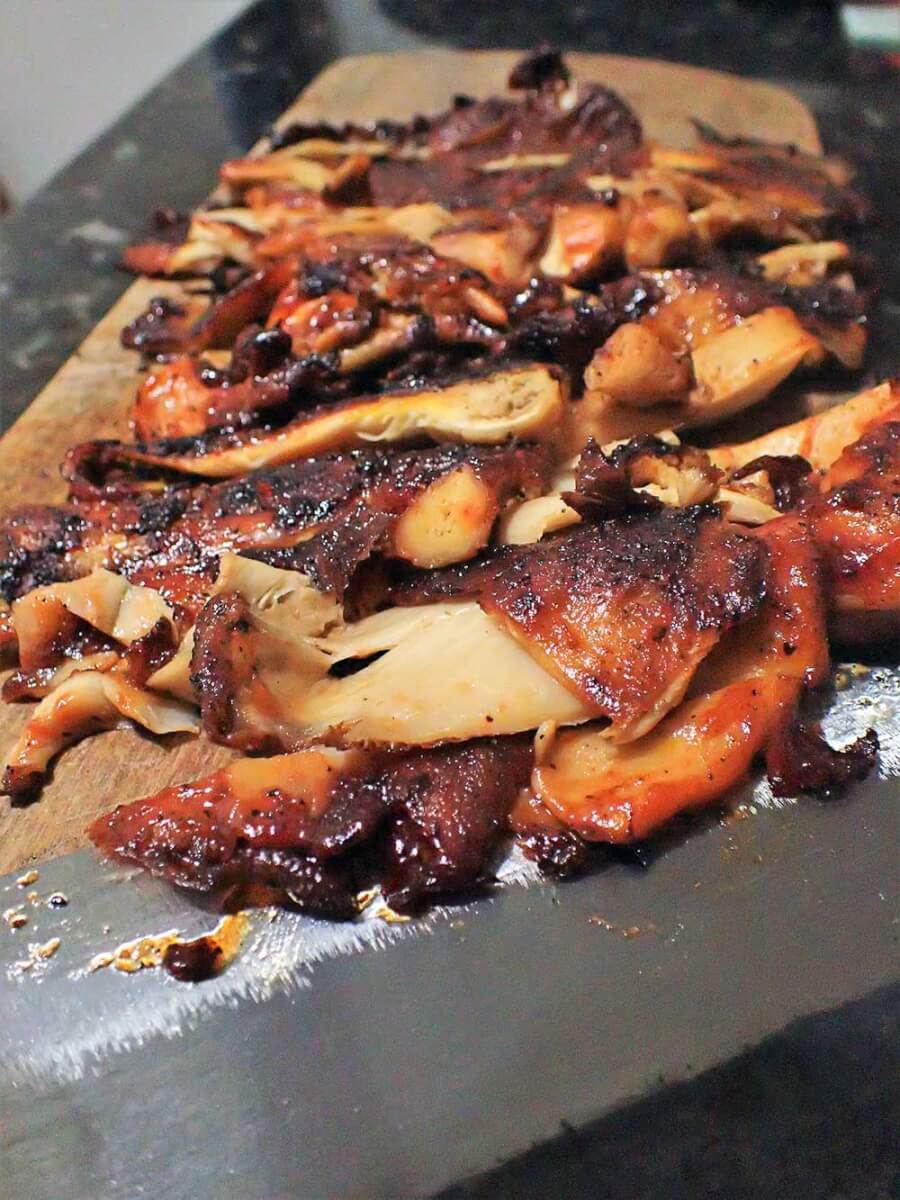
Cap- It starts out as a cloud-looking mass but grows to be fan-shaped. When the mushrooms are fresh, the caps will be primarily white with colors of yellow and gold on the margins. The caps can grow to around 2 to 8 inches in diameter. The interior flesh, which is white and firm, will both darken and get tougher as it ages.
Gills- Because this mushroom is a polypore, it has no gills. This polypore releases its spores from tiny pores that make the surface seem smooth.
Stem- It has a short and thick stem up to about 1-inch long and over 4 inches thick.
Spores- The spore print is white.
Cook- Saute, and add to shredded chicken dishes or chili, where the color will be masked. Many people aren’t fond of eating black food; however, they also do well in a stir fry.
CHICKEN OF THE WOODS (LAETIPORUS)
Quite possibly the easiest fungi to identify is this one. The bright, striking yellow and orange colors make it easy to see from afar. Regarded as a “choice” mushroom, this one is highly sought after. The consistency and taste are akin to chicken and how easily it pulls apart. Some feel it resembles crab meat, making it also crab of the woods—in a way.
How to Identify- Bright orange with yellow edges makes this one pop out in the forest. The base of oaks, still standing or fallen, and other hardwoods commonly in Europe and North America is where to find chicken of the woods. Often found in clusters, there is a floral smell associated with this one.
Cap- Anywhere between 2 to 12 inches wide, clusters can get more than 30 inches across. The flesh starts out soft and juicy and will harden and get flaky in time.
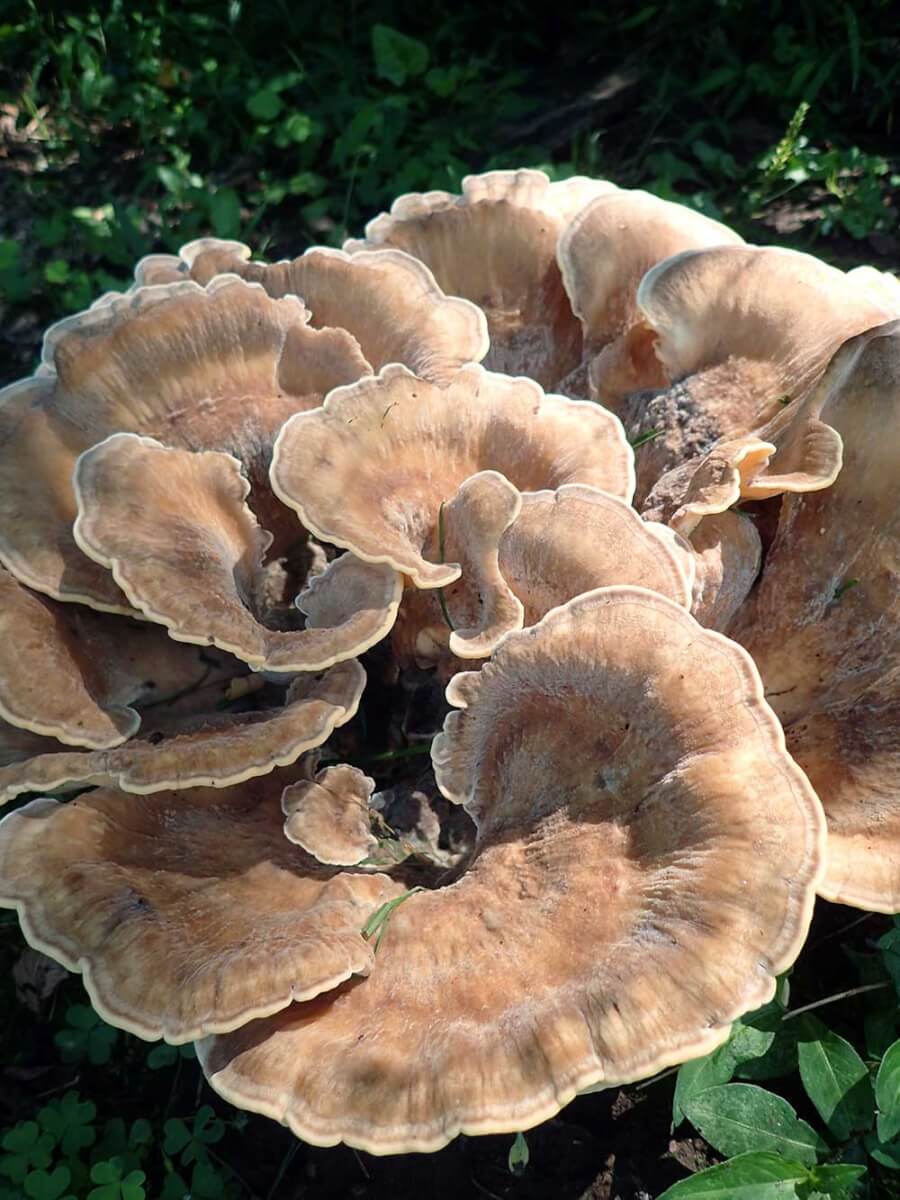
Gills- None.
Stem- None.
Spores- Yellow sulfur-like surface with white spore prints.
Cook- Your imagination is the limit with this one. Making chicken of the woods nuggets is a favorite among foragers. A simple egg wash, flour, Panko, and seasoning (Old Bay/Red Eyed Hog) will work. Deep frying until golden brown, just like chicken, will do it justice. Saute and shred for adding to chili or making chicken of the woods tacos. Chorizo sausage will flavor it well and add the fat content needed to take it to the next level.
Note: Although these mushrooms mentioned have nearly no poisonous lookalikes, the jack o’ lantern mushroom (omphalotus olearius/illudens) is sometimes confused with chicken of the woods or chanterelle mushrooms.
The jack o’lantern poisonous mushroom got its name from its dark orange pumpkin color and the fact that it glows and appears around the Halloween season. The faint glow of the jack o’ lantern mushroom’s gills is caused by a bioluminescent enzyme called luciferase seen at night. Jack o’ lantern mushrooms are poisonous and will result in gastrointestinal distress if eaten. While eating this mushroom will not likely be fatal, it causes extreme nausea, vomiting, and weakness. This mushroom is sometimes eaten when mistaken for edible chanterelle species of mushrooms or chicken of the woods.
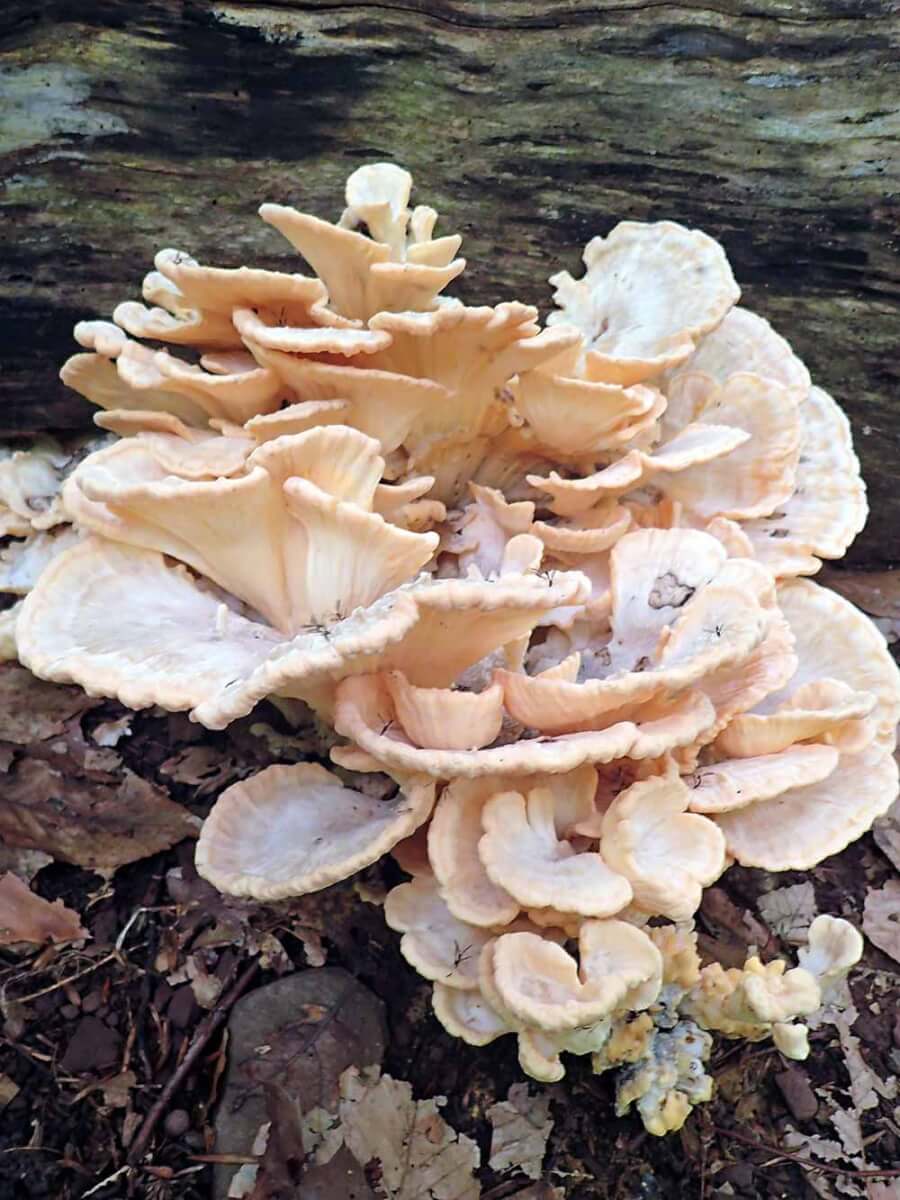
POSITIVE ID
Get three sources of confirmation before trying to ingest wild food. Try a small amount first and cook before eating. Hopefully, this alleviates some of the concerns and prompts people to get out there and enjoy this amazing, fulfilling activity.
If nothing more, photograph, pick, make spore prints, and identify. Practice good mushroom etiquette, leave some for others, and carry your cache out in a mesh bag or basket to help spread more spores, helping with regrowth. Above all else—have fun and happy hunting.
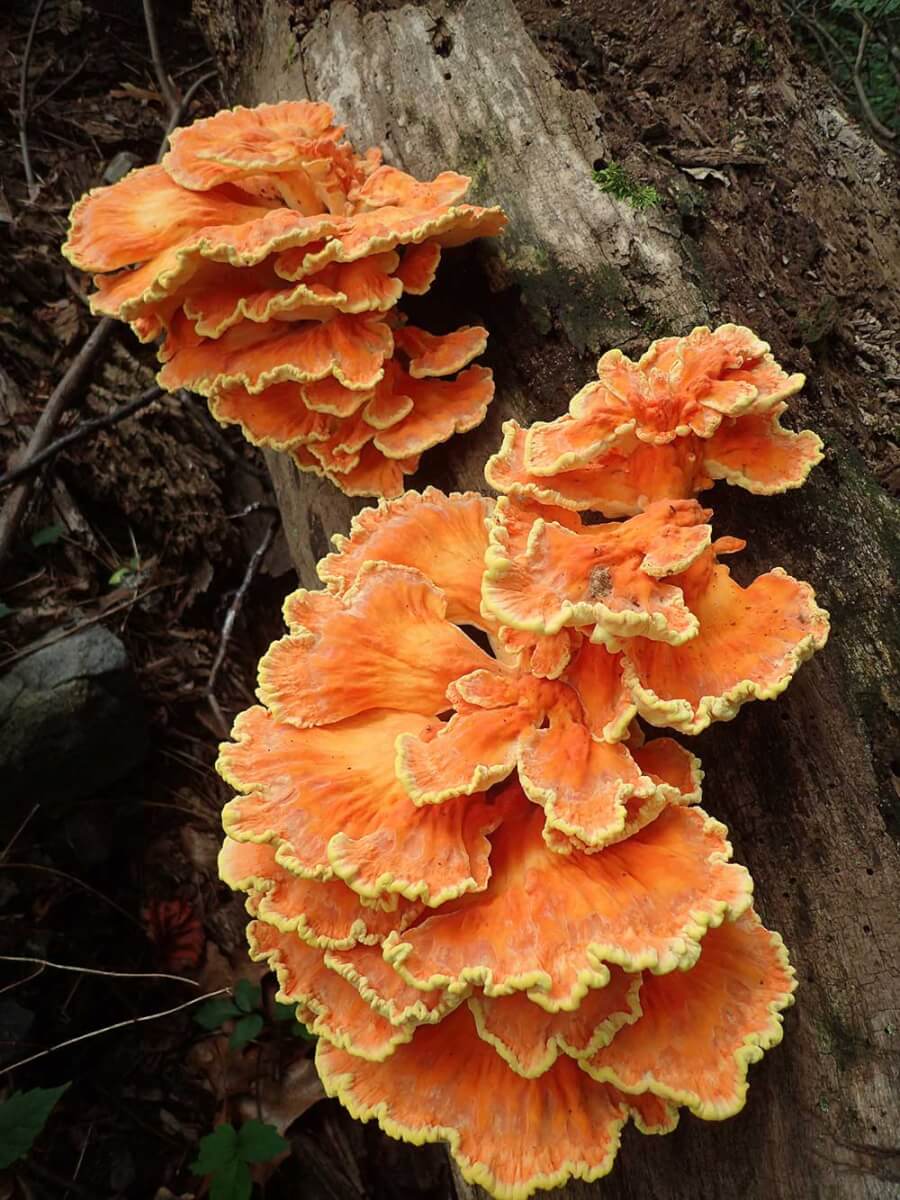
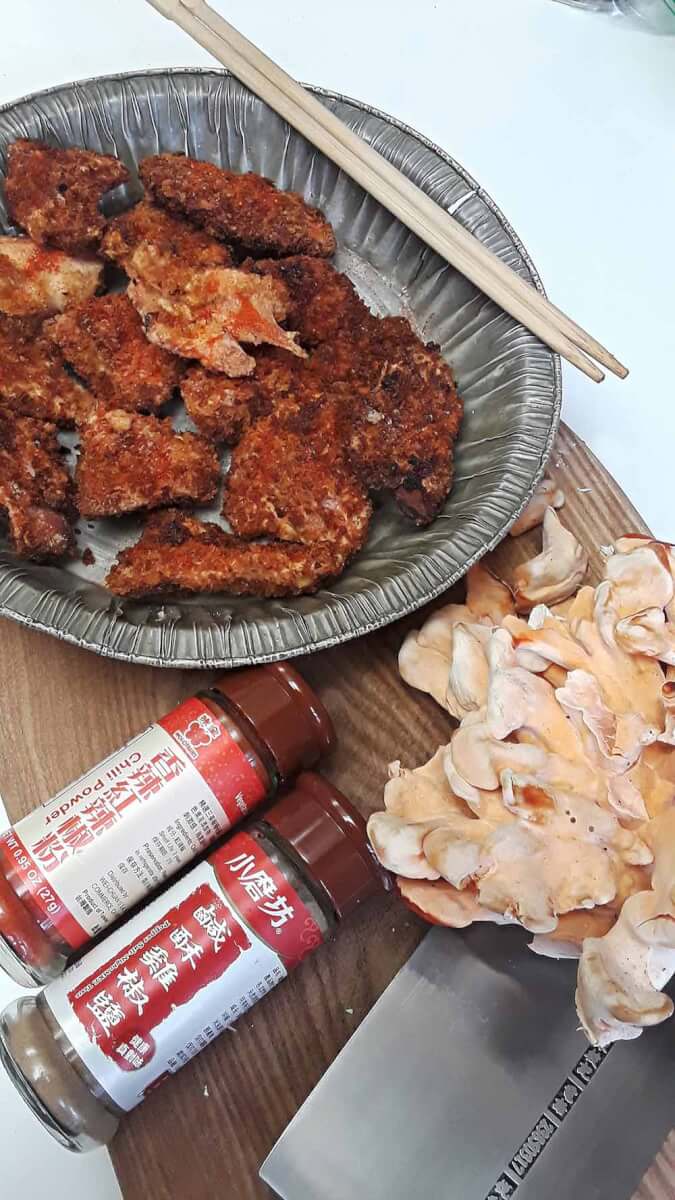
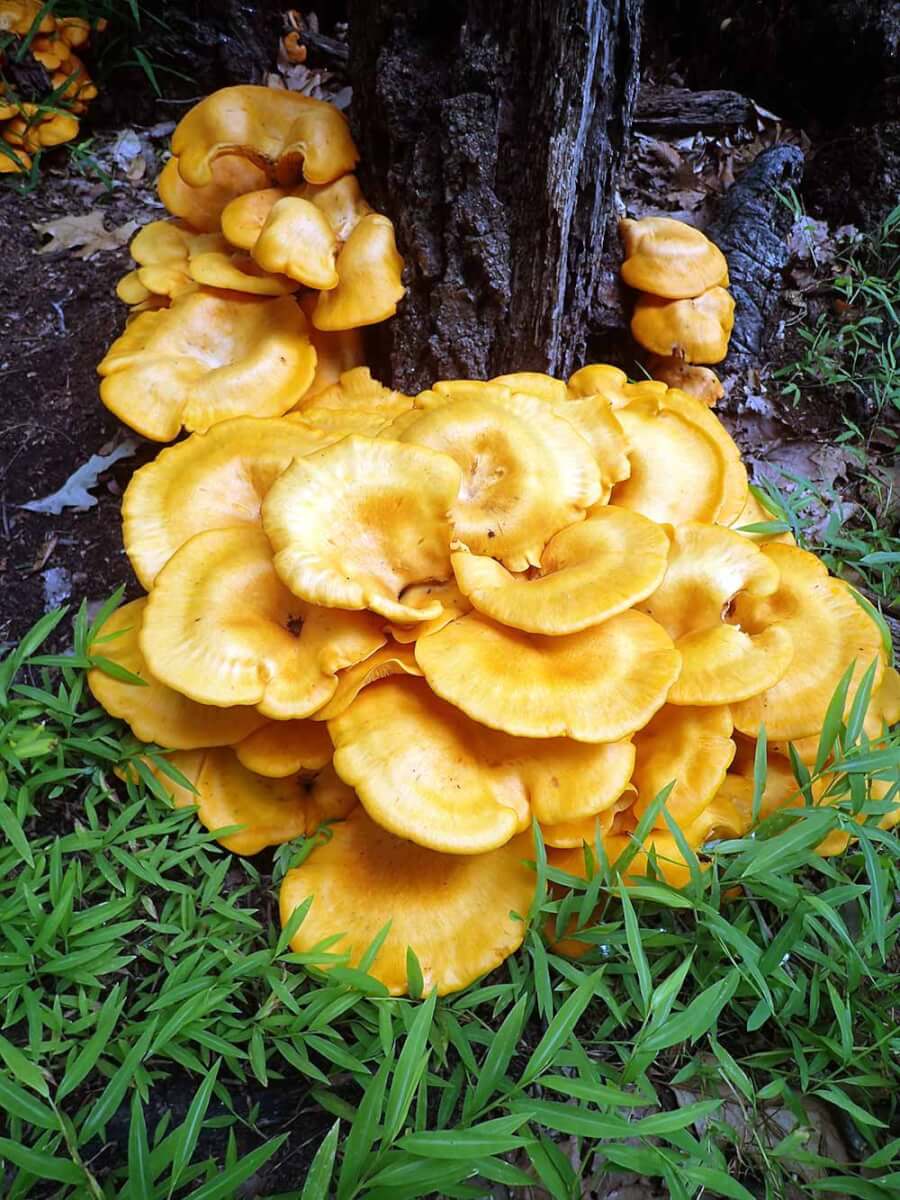
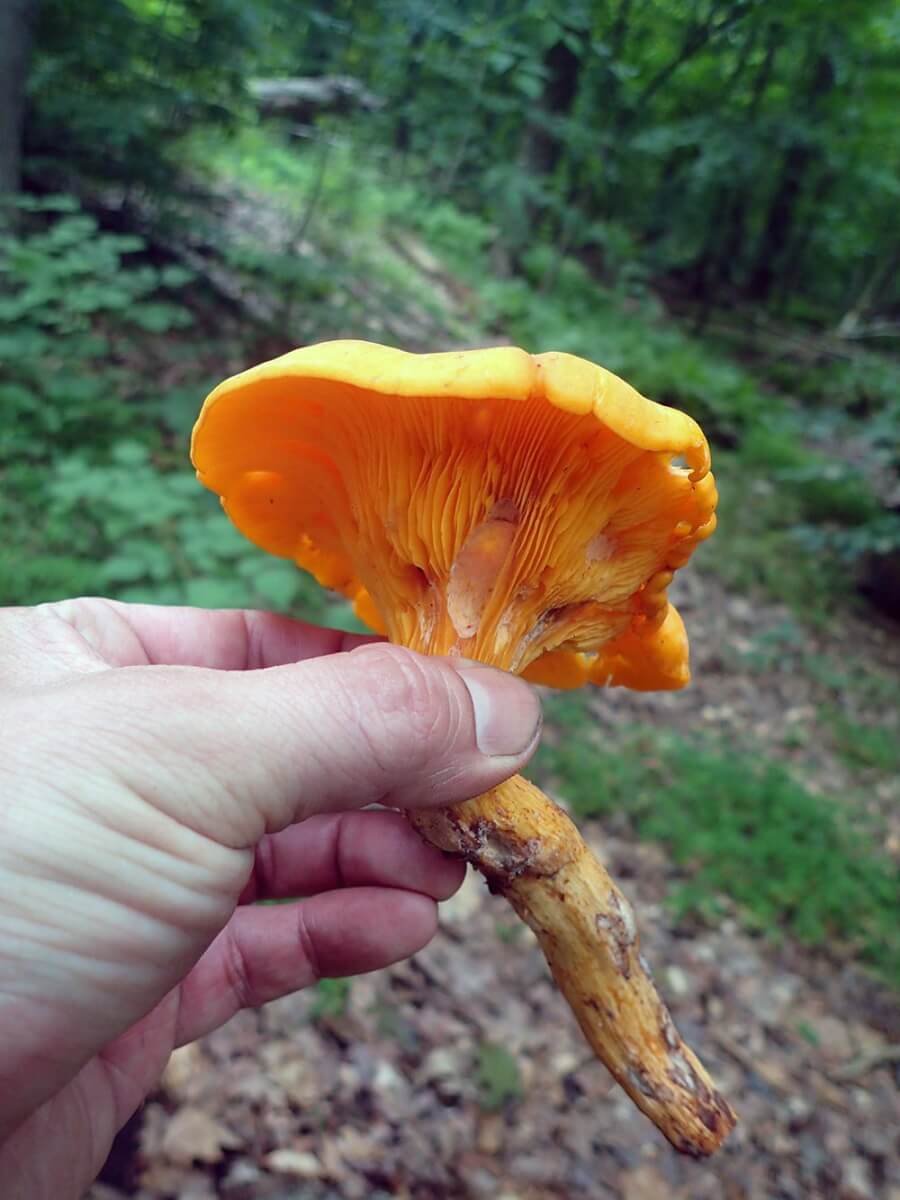
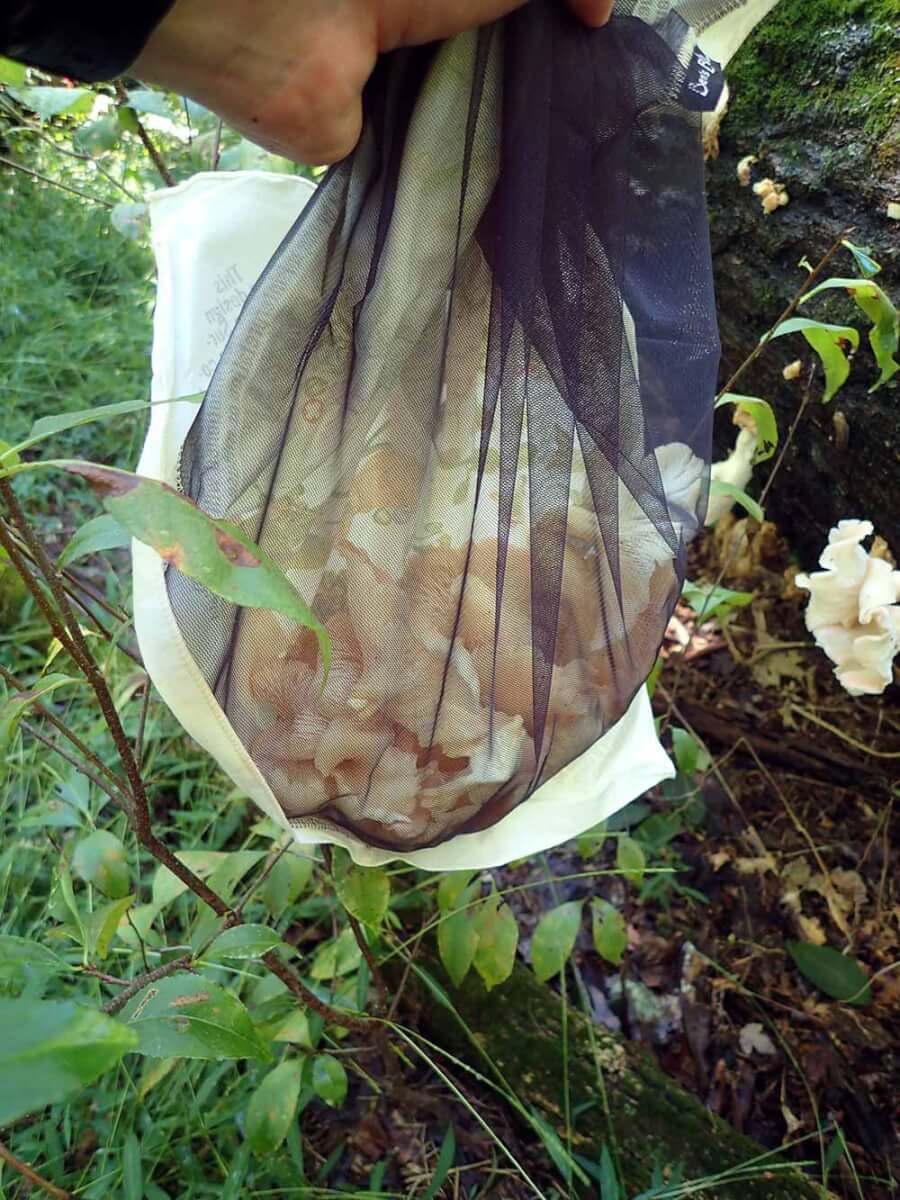
SOURCE
Wazoo Gear
www.wazoosurvivalgear.com
A version of this article first appeared in the September 2022 issue of American Outdoor Guide Boundless.


